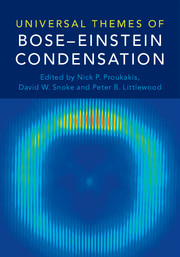Book contents
- Frontmatter
- Contents
- Foreword
- Preface
- Part I Introduction
- 1 Universality and Bose-Einstein Condensation: Perspectives on Recent Work
- 2 A History of Bose-Einstein Condensation of Atomic Hydrogen
- 3 Twenty Years of Atomic Quantum Gases: 1995-2015
- 4 Introduction to Polariton Condensation
- Part II General Topics
- Part III Condensates in Atomic Physics
- Part IV Condensates in Condensed Matter Physics
- Part V Condensates in Astrophysics and Cosmology
- Universal Bose-Einstein Condensation Workshop
- Contributors
- Index
- References
3 - Twenty Years of Atomic Quantum Gases: 1995-2015
from Part I - Introduction
Published online by Cambridge University Press: 18 May 2017
- Frontmatter
- Contents
- Foreword
- Preface
- Part I Introduction
- 1 Universality and Bose-Einstein Condensation: Perspectives on Recent Work
- 2 A History of Bose-Einstein Condensation of Atomic Hydrogen
- 3 Twenty Years of Atomic Quantum Gases: 1995-2015
- 4 Introduction to Polariton Condensation
- Part II General Topics
- Part III Condensates in Atomic Physics
- Part IV Condensates in Condensed Matter Physics
- Part V Condensates in Astrophysics and Cosmology
- Universal Bose-Einstein Condensation Workshop
- Contributors
- Index
- References
Summary
The field of atomic quantum gases has seen rapid and sometimes surprising developments since its beginnings in 1995. In this chapter, I summarize, highlight, and comment on selected topics.
Introduction
Bose-Einstein condensation (BEC) in atomic gases was first observed in 1995, and has changed the face of atomic physics. It is for atoms or matter waves what the laser is for photons: a macroscopically occupied quantum state. It was regarded as an elusive goal until it was discovered in 1995. Although BEC was immediately viewed as a major accomplishment, its impact has far exceeded expectations. Now, twenty years on, there is no question that the field remains exciting.
It is impossible to give a review over the developments during those twenty years. Instead, in this chapter, I want to illustrate how often predictions or expectations changed in the pursuit of Bose-Einstein condensation. There were many surprises, and some advances and breakthroughs happened although they were predicted to be impossible. A lesson we can learn from this is that we should always carefully read the fine print when something is proven or assumed impossible, and try to figure out if the assumptions can be circumvented!
Since the early history of Bose-Einstein condensation provides several examples for such “impossibility theorems,” I digress into those earlier developments in the first part of this chapter.
Early Theoretical Questions
Validity of the Prediction of Bose-Einstein Condensation
Einstein predicted Bose-Einstein condensation in 1924 in the second of two papers where he generalized Bose's treatment from photons to massive particles [1]. Using statistical arguments introduced by Bose, he found that below a critical temperature, bosonic particles condense in the lowest energy state of the system. In contrast, at very low temperature photons can simply disappear.
However, for about a decade, this prediction was not taken at face value. Einstein himself wrote to Ehrenfest, “From a certain temperature on, the molecules ‘condense’ without attractive forces; that is, they accumulate at zero velocity. The theory is pretty, but is there some truth in it?” [2].
In 1927, George E. Uhlenbeck concluded that the predicted BEC phase transition was an artifact of the replacement of the summation over states by an integral and wrote that no “splitting into two phases” would occur [3].
- Type
- Chapter
- Information
- Universal Themes of Bose-Einstein Condensation , pp. 38 - 56Publisher: Cambridge University PressPrint publication year: 2017



